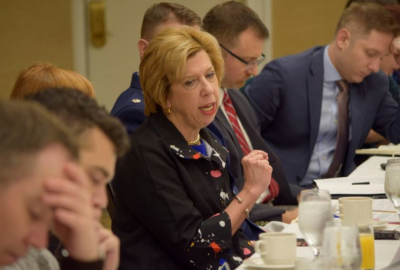For DoD, new flexibility for IT spending is a test of trust with Congress
Early signs suggest Congress is ready to let DoD expand pilot programs that use colorless appropriations for IT, but not without limitations.
When it comes to implementing modern software development techniques, one of the Defense Department’s biggest problems has been its own budgeting system. The procurement, R&D and operations buckets the military uses to fund the development of missiles, frigates and tanks are anything but agile.
But Congress has signaled that it’s ready to expand DoD’s use of “colorless” money for software, and Defense officials think it will be critical to future acquisitions, as long as the department doesn’t get in its own way by misusing the new spending authority.
There’s no telling exactly when lawmakers will approve full spending plans for the fiscal year that starts next week, but DoD has good reason to believe the final package will include permission to continue and expand its experiment with colorless money for software and IT programs. The House’s version of the Defense spending bill includes permission for 12 of the pilots in 2022 — up from nine this fiscal year, the first year in which the experiment’s been tried.
Under those pilots, program managers and program executive officers are given access to money that’s good for two years, and also isn’t segregated into the traditional funding lines that were developed for military hardware. The concept has been championed by the Defense Innovation Board, the Section 809 Panel, and Ellen Lord, DoD’s former acquisition chief.
In its budget for 2022, the Department of the Air Force asked for three pilot programs, including two that would leverage the colorless money concept for the first time. The approach is a “game changer,” said Gen. Arnold Bunch, the commander of Air Force Materiel Command.
“You no longer have sustainment, development and procurement money. If you can show me where the line is between sustainment, development and production — particularly in the agile, secure DevOps environment we’re moving to — please come and explain that to me, because I can’t find the line,” he said this week at the Air Force Association’s annual conference in National Harbor, Maryland. “It’s a great authority Congress has given us. We don’t have to go back and reprogram. We can take the money that is there and use it where we need to.”
For the Air Force, House appropriators approved the use of pilots for a suite of software applications called the Strategic Mission Planning and Execution System, the Defense Enterprise Accounting and Management System (DEAMS), and the Space Force’s Kobayashi Maru project, which was also part of the first year of colorless money pilot programs.
The fact that appropriators were willing to add new systems to the process this year appears to indicate they’ve seen no significant problems so far.
But Bunch said the trust lawmakers have shown could be easy to lose if program managers aren’t careful.
“Congress has given us an authority we did not have, and we need to immediately come forward if we have a problem. We cannot wait and try to hide it [from the Hill],” he said. “As leaders, if we have somebody who tries to hide a problem, we’ve got to schwack them, because this is a trust issue. We have to communicate what we’re doing. And as soon as we have a success with this, we’ve got to trumpet it. We’ve got to raise it up so that the chief and the secretary know what it is.”
But the House bill also shows appropriators are still approaching the colorless money pilots with a certain degree of caution. The chamber’s appropriations committee declined to approve DoD’s largest proposed pilot for 2022: the Navy’s Next Generation Enterprise Network program.
The Navy had proposed moving its entire NGEN program into the new software appropriation, even though the long-running, multi-billion dollar program is much more expansive than software development. At $955 million in 2022 spending alone, it would have been the biggest software and digital technology pilot by far.
Jane Rathbun, the deputy assistant secretary of the Navy for information warfare and enterprise services said Navy IT officials would have liked to tee up even more IT programs for the colorless pilots, but budget officials worried the service was already pressing its luck by requesting the authority for a program as large as NGEN. As it turned out, the budget folks were right.
“The size of the NGEN budget surprised the Hill — they weren’t thinking pilots would be of that size,” she said during a panel discussion at the Navy League’s recent Sea Air Space conference. “But the concept is to use a single color of money throughout the lifecycle of IT and software management, because it doesn’t behave like a weapon system. I’ve talked to a hundred people who spend six months with their lawyers deciding whether or not they can use procurement or O&M funding for things. I mean, that slows us down. It would be a cultural shift for the entire Department of Defense, and really enable a DevSecOps culture.”
Another big culture change for both appropriators and for DoD acquisition managers would be to start allocating funds not just with colorless money — but by portfolio, instead of allocating funds to individual programs. Outside advisory boards have urged the department and Congress to adopt that approach too.
DoD has also asked Congress for permission to pilot the concept. Lawmakers haven’t yet embraced it, but Defense officials think it would pair well with the idea of no-color money, said Lt. Gen. Duke Richardson, the top military official in the office of the assistant secretary of the Air Force for acquisition, technology, and logistics.
“Let’s say you just took air dominance — take all of our air dominance programs and put them together, along with reporting mechanisms back to Congress that are very transparent. If we have a program that stumbles a little bit, it would be nice if we could very quickly pivot that money to something else that’s waiting and ready to go,” he said. “I think we could put in mechanisms that would allow us to report that change, but would at least stay inside that same mission area … I would love to be able to explore that. We want flexibility, but we also want [funding] on time so that we’re not constantly in a re-plan.”
But Bunch said getting Congress’s assent for that kind of flexibility comes back to trust — another reason to make sure the software color of money pilots stay scandal-free.
“For those organizations that have that authority to use colorless money — please, we need radical transparency. We have got to do this right so that we can expand this out later on.”
Copyright © 2025 Federal News Network. All rights reserved. This website is not intended for users located within the European Economic Area.
Jared Serbu is deputy editor of Federal News Network and reports on the Defense Department’s contracting, legislative, workforce and IT issues.
Follow @jserbuWFED







